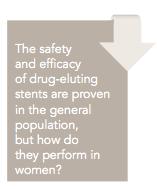Safety and Efficacy of Drug-Eluting Stents in Women
The safety and efficacy of drug-eluting stents are proven in the general population, but how do they perform in women?

Pareena Bilkoo, MD, FACC
Review

Lancet.
Stefanini GG, Baber U, Windecker S, et al. Safety and efficacy of drug-eluting stents in women: a patient-level pooled analysis of randomized trials. 2013;382:1879-1888.
D
rug-eluting stents (DESs) have become the standard of care for significant coronary artery disease (CAD).1 Since the introduction of these stents in 2002, with initially the early-generation DESs and recently the newer-generation DESs, the safety and efficacy of these devices has been proven and well established. Specifically, when compared with bare-metal stents (BMSs), DESs have demonstrated significant reductions in repeat revascularization rates.2 In the vast majority of stent trials, women are underrepresented, comprising approximately 25% of the study populations; whereas in North America women receive roughly one-third of the 500,000 DES procedures annually.3 The safety and efficacy of DESs in the general population is established, but the same has not been determined in women as a subgroup. To this end, the Women in Innovation Initiative formed the Gender Data Forum in 2012 to examine the safety and efficacy profile of DESs in women.
Study Design
Stefanini et al analyzed 26 randomized DES trials in a patient-level pooled analysis.4 The end points were prespecified during the Gender Data Forum. Manufacturers of stent companies were contacted for female participant data and then pooled. There were no inclusion or exclusion criteria. All 26 trials were carried out over a 13-year period (2000-2013). There were 43,904 total participants in all 26 trials, of which 11,557 participants (26.3%) were women. Three groups were analyzed, 1108 received BMSs (9.6%), 4171 received early-generation DESs (36.1%), and 6278 received newer-generation DESs (54.3%). Patients enrolled in the trials spanned the spectrum from those with stable coronary disease to unstable angina, non-ST-elevation myocardial infarction (NSTEMI), and STEMI.
The prespecified primary safety end point was the composite of death or MI. The primary efficacy end point was target-lesion revascularization (TLR). The secondary safety end point was definite or probable stent thrombosis, and other secondary end points were individual components of the primary safety end point, definite stent thrombosis, and major adverse cardiac events (composite of death, MI, or TLR).
Statistically, the data were aggregated and combined on a prespecified data sheet. Baseline data of all 3 stent groups were compared with a linear regression for continuous variables and
χ
2
P
for categorical variables. Kaplan-Meier methodology was used to calculate the cumulative event rates and then compared with the log-rank test. As the length of the various trials differed, the event rates for the groups were calculated for 0 to 3 years, 0 to 1 year, and 1 to 3 years. Follow-up was defined as the time from index procedure until death, last follow-up date, or 3 years, whichever came first. The BMS group was used as the reference for all analyses. values of less than 0.05 were deemed significant.
Of the 11,557 women enrolled and thus analyzed by Stefanini et al,4 the mean follow-up overall was 2.9 years. Baseline characteristics showed a mean age of 67.1 years; 31.2% had diabetes, 75.6% had hypertension, and 67.6% had hypercholesterolemia. A total of 26.7% were smokers and 28.8% had multivessel disease. Of the group, 43.8% underwent stenting for acute coronary syndrome (ACS) and the remaining 56.2% for stable coronary disease.
P
P
P
P
P
P
P
P
P
Clinical outcomes at the end of 3 years showed that death occurred in 5.7% of all enrollees (overall value, .22). MI was significantly different ( = .0003), with 7.7% occurring in the BMS group, 6.0% in the early-generation DES group, and 4.8% in the newer-generation DES group. A difference in rates of MI between the early- and newer-generation DES groups (= .03) was also noted. Rates of definite stent thrombosis were also significantly different, 0.8% in the BMS group, 1.4% in early-generation DESs, and 0.6% in newer-generation DESs, with an overall value of .0005 and between the early- and newer-generation DESs ( = .0001). TLR rates were higher in the BMS group (18.6%) than in the early-generation DES group (7.8%) and newer-generation DES group (6.3%), with an overall value of <.0001; between the early and newer-generation DESs, = 0.005. Major adverse cardiac events (MACEs) were significantly higher (<.0001) in the BMS group (27.7%) than the early DES group (16.5%) and newer-generation DES groups (14.1%). MACE rates were lower ( = .002) in the newer DES group versus the early-generation DES group.
P
P
P
P
P
P
P
P
The authors used a multivariable analysis and adjusted the baseline differences for each stent group and calculated hazard ratios (HRs). HRs were not different for death or MI ( = .67; 95% confidence interval [CI], 0.69-1.27) between the BMS and early-generation DES group, but HRs were different between the BMS and newer-generation DES groups ( = .03; 95% CI, 0.51-0.97). Definite or probable stent thrombosis was not significantly different between the BMS group and both the early- (95% CI, 0.41-2.17; = .91) and newer-generation DES groups (95% CI, 0.24-1.26; = .16), respectively. Interestingly, between the DES groups there was a significant difference in definite or probable stent thrombosis ( = .02). The authors found the stent thrombosis rates to be lower in the BMS group (1.3%) versus the early-generation DES group (2.1%), but higher when compared with newer-generation DES group (1.1%). These differences were primarily related to very late (>1 year) thrombosis rates. Stefanini et al did find a significant difference in TLR rates between both the BMS and early-generation DES groups (95% CI, 0.33-0.65; <.0001) and between the BMS and the newer-generation DES group (95% CI, 0.31-0.64; <.0001). Using a stratified analysis of death or MI and TLR, Stefanini et al found that DESs, both early- and new-generation, were favored over BMSs in women regardless of age, smoking history, ACS, multivessel disease, or a previous history of MI. A significant ( = .01) interaction was noted between treatment type and patients with diabetes, favoring BMSs compared with newer-generation DESs.
CommentaryConsistent Results for DESs in Women
D
rug-eluting stents have become the standard of care for CAD and are used in the majority of real-world percutaneous procedures.1,3 The safety and efficacy of DESs have been established in a variety of coronary disease presentations (stable/unstable CAD, NSTEMI, STEMI) based on multiple studies in the past decade.1-3 Based on the data available, women are underrepresented in stent trials, making up only a small proportion of study participants. Although the advantages of DESs reported are in all comers, definitive evidence lacks for DESs in women specifically.
DESs have been shown to improve rates of TLR and decrease future incidence of MI. The newer-generation DESs have reduced rates of stent thrombosis.1-3 Stefanini et al set out to analyze 26 studies and extract data for DESs in women, and found the results in women to be consistent with those for men. Similar to the larger all-comer trials and studies, the authors did not find a difference in mortality when comparing stent types in women. Very late stent thrombosis (>1 year) rates were higher with early-generation DESs compared with the BMS group, and were lowest with the newer-generation DESs, illustrating technical advances in stent design and suggestive of improved drug elution and procedural techniques. An important factor in stent selection for many interventional cardiologists is TLR, and the authors found improved rates with both groups of DESs—the lowest rate in women with the newer-generation DESs, again consistent with the larger stent trials. Of interest, Stefanini et al discovered in a stratified analysis for death or MI that BMSs are statistically more favorable in women with diabetes. As a subgroup, people with diabetes tend to have more complex, calcified lesions with greater major adverse events related to both stents and de novo progression of coronary disease.6 This finding needs further investigation with a standard randomized trial.
The undertaking of this observational analysis by the authors is of clinical importance, especially considering the scarcity of evidence about efficacy and safety of DESs specifically in women. The authors duly note the disadvantages of an observational study versus a randomized trial, though the study is a definite starting point. Possible explanations for the lack of women in larger stent trials may be their older age at presentation of CAD and the presence of other health issues, thereby excluding them from study, or simply the absence of desire to participate in trials. These factors may need to be considered when formulating a trial designed for women.
 
References
N Engl J Med
1. Stefanini GG, Holmes DR Jr. Drug eluting coronary-artery stents. . 2013;368:254-265.
Lancet.
2. Stettler C, Wandel S, Allemann S, et al. Outcomes associated with drug-eluting and bare-metal stents: a collaborative network meta-analysis. 2007;370:937-948.
Circulation
3. Go AS, Mozzaffarian D, Roger VL, et al. Heart disease and strokes statistics—2013 update: a report from the American Heart Association. . 2013;127:e6-e245.
Lancet.
4. Stefanini GG, Baber U, Windecker S, et al. Safety and efficacy of drug-eluting stents in women: a patient-level pooled analysis of randomized trials. 2013:382:1879-1888.
5. Society for Cardiovascular Angiography and Interventions Foundation. Women in Innovations and the American College of Cardiology Gender Data Forum II: DES revascularization and complex PCI. www.scai.org/WIN/News/detail.aspx?cid=3ddc5e55-8432-4cdd-8e65-c7f76d024ac0.
N Engl J Med.
6. Farkouh ME, Domanski M, Sleeper LA, et al. Strategies for multi-vessel revascularization in patients with diabetes. 2012;367:2375-2384.
About the Author
Pareena Bilkoo, MD, FACC, is an interventional cardiologist and director of the cardiac catheterization laboratory at East Georgia Regional Medical Center in Statesboro, GA.
